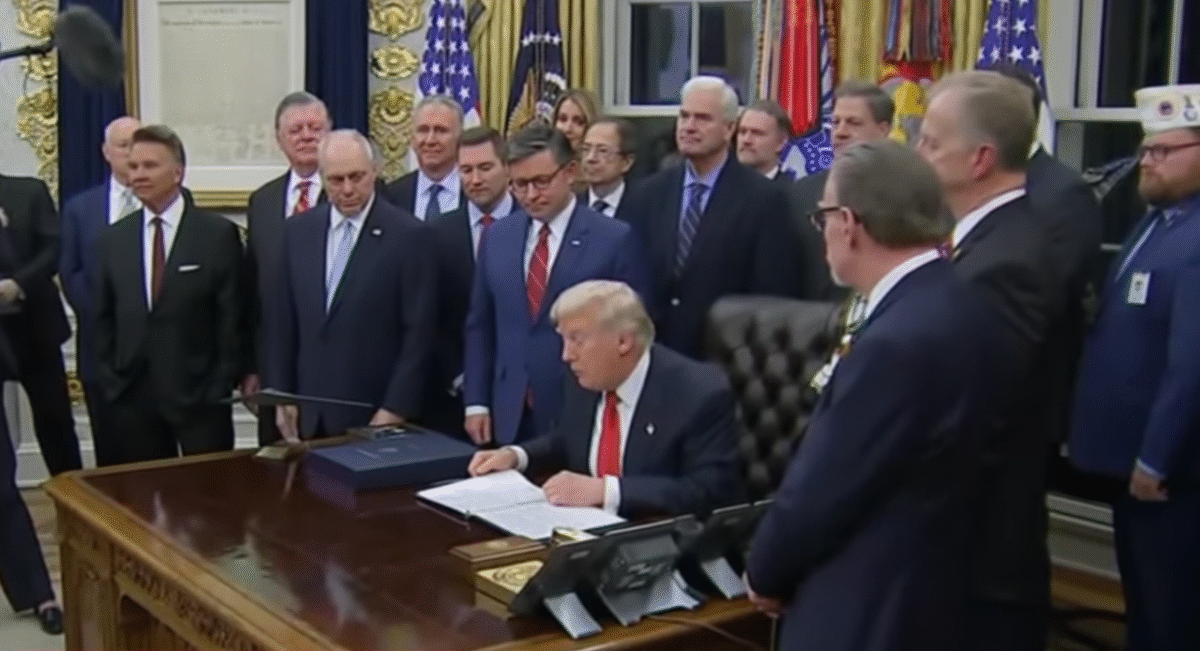The longest government shutdown finally came to an end with a quick vote and a presidential signature — proving what many Americans suspected from the start: this entire ordeal could have been avoided. After seven weeks of political theatrics, postponed paychecks, and enough airport delays to make people consider cross-country hitchhiking, Congress ultimately passed a temporary bill they could have agreed to on day one. If irony had a face, it would be shaking its head right now.
The shutdown was sold as a bold political stand. In reality, it was more like a very expensive, very exhausting group project where half the participants refused to read the assignment. And the American people, as usual, were the ones stuck cleaning up the mess. The key takeaway from this whole saga? Washington may have reopened, but it didn’t necessarily wise up.
Democrats Tried a High-Stakes Gamble — and It Didn’t Pay Off
Here’s the first perspective readers deserve to see clearly: Democrats attempted to use the shutdown as leverage to force the extension of certain Obamacare tax credits. Whether someone agrees or disagrees with their policy goals, the strategy itself was, to put it gently, overly optimistic.
They held out for weeks, hoping Republicans would fold under the pressure. Instead, the final bill passed without the add-ons Democrats wanted, and millions of Americans were left wondering why their government stopped functioning just so politicians could argue about something that wasn’t even included in the temporary funding package.
This wasn’t a case of one side “winning” or “losing.” It was a reminder that turning federal workers into bargaining chips rarely ends well. And for many Americans who rely on paychecks from federal agencies, the shutdown didn’t feel like a political chess match. It felt like unnecessary disruption.
Republicans Held the Line — But There’s Still a Bigger Picture
The second perspective worth highlighting is how Republicans approached the shutdown. They returned to Washington after seven weeks and ultimately passed a short-term bill keeping funding levels steady until January. That part was straightforward. What wasn’t straightforward was the fact that the shutdown happened in the first place.
Supporters argue Republicans demonstrated discipline by resisting pressure to add unrelated healthcare provisions into a stopgap bill. Critics argue both parties contributed to the stalemate. But one fact remains: the shutdown ended with nearly the same funding language that was on the table weeks earlier.
If the goal was to show resolve, Republicans did that. If the goal was to show Congress can function efficiently, well… there’s always next year.
The Shutdown Was a Reminder of Just How Dysfunctional Washington Has Become
Now for the third perspective — the one millions of Americans intuitively understand. Every few years, Congress seems determined to prove that budgeting for the world’s most powerful nation is somehow harder than assembling furniture without instructions.
Government shutdowns shouldn’t be a recurring national tradition. They create instability, uncertainty, and real financial hardship for federal workers and families relying on essential services. Yet Washington keeps using them as bargaining tools, as though disruption is just part of the political process.
Imagine a business that shuts down every time management disagrees on a spreadsheet. That business wouldn’t last long. But in Washington, this behavior has become routine. This shutdown — the longest government shutdown we’ve ever endured — should be a wake-up call for lawmakers to implement guardrails, such as automatic continuing resolutions, so Americans aren’t forced to brace for impact every fiscal year.
A Shutdown That Hurt More Than Just Poll Numbers
What made this shutdown especially frustrating was how predictable the outcome was. Lawmakers warned early on that the final deal would ultimately resemble the opening proposal. And they were right. This wasn’t a case of a grand bargain emerging from spirited debate. It was more like a very long, very expensive pause button.
Meanwhile, federal employees missed paychecks. Airport staffing thinned out. Families dependent on federal services were forced into limbo. And for what? So Congress could confirm what experts said from the beginning — that the deal would land exactly where it started.
The longest government shutdown didn’t produce innovation, compromise, or a landmark policy shift. It produced inconvenience, exhaustion, and a collective national sigh.
The Obamacare Tax Credit Battle Isn’t Over
Democrats made clear they intend to continue fighting for the extension of health insurance tax credits set to expire soon. This shutdown won’t be the last chapter in that debate. And to be fair, everyone deserves clarity on their premiums — especially with healthcare costs already weighing heavily on families.
But targeting a shutdown as the battleground for that policy debate was never a productive strategy. The American people deserve legislative discussions that don’t hinge on government closures.
There will be time for that debate. There will be hearings, votes, negotiations, and town halls. But none of those require shuttering national parks or delaying travel plans.
The Path Forward
January’s deadline will arrive quickly. And when it does, the same urgency that wrapped up this shutdown should be applied before another one begins. Congress has the opportunity — and responsibility — to put long-term reforms on the table.
If policymakers want to earn back trust, preventing a sequel to the longest government shutdown would be a good place to start. Americans are patient, but patience has limits. And seven weeks of policy standoff is well past most people’s comfort zone.
Washington can do better. The real question is whether it chooses to.
Closing Thoughts on the Longest Government Shutdown
The longest government shutdown is over, but the lessons remain. Democrats overplayed their strategy. Republicans held firm. And Americans endured the consequences of a political disagreement that didn’t require a nationwide pause.
There’s a smarter path forward — one where government funding isn’t used as leverage, where workers and families aren’t drawn into legislative battles, and where leadership isn’t measured by how long politicians can hold out, but by how effectively they can deliver results.
Maybe this shutdown will finally convince lawmakers that sensible budgeting shouldn’t be treated like a novelty act. One can hope.
Editor’s Note: This article reflects the opinion of the author.
WE’D LOVE TO HEAR YOUR THOUGHTS! PLEASE COMMENT BELOW.
JIMMY
We welcome open discussion and thoughtful opinions — even strong disagreements — but comments containing profanity, personal attacks, or hate speech will be removed. Keep it civil, keep it smart, and keep it focused on the ideas.
h/t: Steadfast and Loyal








Leave a Comment